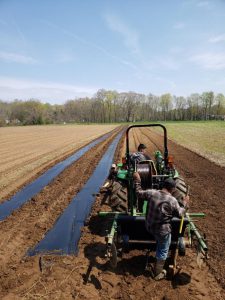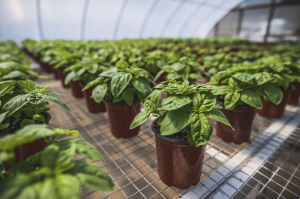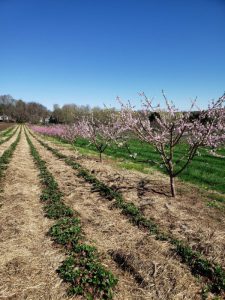 The most important time of year for a farmer is spring. Grounds have thawed out, rain has been pouring in, and temperatures are finally rising!! A lot is going on this time of year, but there is of course some obstacles to overcome. This year the rain has been even more than usual, creating difficult conditions on the farm as we are trying to get work done. With brief openings from the rain, we had some time to lay plant biodegradable plastic. Planting on biodegradable plastic makes weeds less of an issue, we can run drip irrigation tubing under it, is easy to transplant into, and it breaks down at the end of the season, sometimes before we would like. We have planted Carrots, Swiss Chard, Beets, and new to us, Spigiarello Broccoli. Weeds are a constant problem with direct seeded crops, so we need to be diligent and keep them under control. Plastic will be used for crops that can be started in the greenhouse and transplanted. Some crops don’t transplant well (see economics) so those are direct seeded.
The most important time of year for a farmer is spring. Grounds have thawed out, rain has been pouring in, and temperatures are finally rising!! A lot is going on this time of year, but there is of course some obstacles to overcome. This year the rain has been even more than usual, creating difficult conditions on the farm as we are trying to get work done. With brief openings from the rain, we had some time to lay plant biodegradable plastic. Planting on biodegradable plastic makes weeds less of an issue, we can run drip irrigation tubing under it, is easy to transplant into, and it breaks down at the end of the season, sometimes before we would like. We have planted Carrots, Swiss Chard, Beets, and new to us, Spigiarello Broccoli. Weeds are a constant problem with direct seeded crops, so we need to be diligent and keep them under control. Plastic will be used for crops that can be started in the greenhouse and transplanted. Some crops don’t transplant well (see economics) so those are direct seeded.
At the end of April, we began to harvest asparagus. Asparagus has a very finite harvest season. Seven weeks is the harvest period from when the first spears are cut, to the last. Weather plays a great role in the production. In cooler weather like we have been experiencing intermittently, asparagus doesn’t grow very quickly. Right now, we are cutting 175-200 pounds a day off of two acres. It must be cut every day regardless of how much is cut. In warmer weather, we cut 300-350 pounds a day. This crop is the only one that we raise, where production is most affected by the weather (excluding hail or natural disasters). We hope to continue harvesting asparagus through to mid-June.
 A lot of change is happening in our greenhouse. We produce about 100,000 transplants out of the greenhouses. Our vegetable transplants are produced on a schedule so they go out in good, warm weather, usually after mid/late May to mid-June. However, not all of the transplants are for vegetable crops. Flowers are a big part of our transplants grown too. The bouquets sold in the store and for our CSA program are produced from these transplants. So, when you see a sign over tomatoes, squash, flowers or maybe cucamelons, that says “Bishop’s Own” you will know that it was started by seed on the farm, grown on the farm and traveled only a short distance to you at the store. Our greenhouses are getting quite full, with mother nature not much help. Even with the best planning, Mother Nature always manages to get the last say. This can make a full house even fuller when transplants are ready to go but excessive rain and cold tells you otherwise. Potted herbs were transplanted in March so that they could make their debut by the beginning of May. To keep the plants in the store until early September we seed every 10-14 days.
A lot of change is happening in our greenhouse. We produce about 100,000 transplants out of the greenhouses. Our vegetable transplants are produced on a schedule so they go out in good, warm weather, usually after mid/late May to mid-June. However, not all of the transplants are for vegetable crops. Flowers are a big part of our transplants grown too. The bouquets sold in the store and for our CSA program are produced from these transplants. So, when you see a sign over tomatoes, squash, flowers or maybe cucamelons, that says “Bishop’s Own” you will know that it was started by seed on the farm, grown on the farm and traveled only a short distance to you at the store. Our greenhouses are getting quite full, with mother nature not much help. Even with the best planning, Mother Nature always manages to get the last say. This can make a full house even fuller when transplants are ready to go but excessive rain and cold tells you otherwise. Potted herbs were transplanted in March so that they could make their debut by the beginning of May. To keep the plants in the store until early September we seed every 10-14 days.
We had a nice peach bloom and hopefully a nice set (pollination). In peaches, it’s better to have too many blossoms than too few to assure proper fruit spacing, but it also means we will have a lot of thinning to do. Thinning is required to get fruit size, balance the crop load, and minimize the potential for broken limbs. We tell our help that you want fruit about six inches apart. Assume each peach is 2.5-3 inches we would maximize fruit spacing. A branch that is 24 inches long could theoretically hold four Peaches. Peach thinning, done when they are the size of an adult’s thumb, is very time consuming, and can take anywhere from thirty minutes to an hour to do a tree. That makes thinning very expensive, but since spacing is critical, hand thinning is the best way.
 When we plant a new block of trees it will take three to four years to get a viable crop, so to help cover the cost we will, where we can, inter-plant Strawberries. Strawberries will only produce economically three or sometimes four years, so it is the perfect crop to plant every other row in a new peach block. When we finish harvesting the berries this June, we will take the pants out and plant grass in the middle. Strawberry blossoms are in and so far, it is looking to be a promising season. We hope to have our own strawberries in the farm market early to mid-June, and available for pick your own at the end of June.
When we plant a new block of trees it will take three to four years to get a viable crop, so to help cover the cost we will, where we can, inter-plant Strawberries. Strawberries will only produce economically three or sometimes four years, so it is the perfect crop to plant every other row in a new peach block. When we finish harvesting the berries this June, we will take the pants out and plant grass in the middle. Strawberry blossoms are in and so far, it is looking to be a promising season. We hope to have our own strawberries in the farm market early to mid-June, and available for pick your own at the end of June.